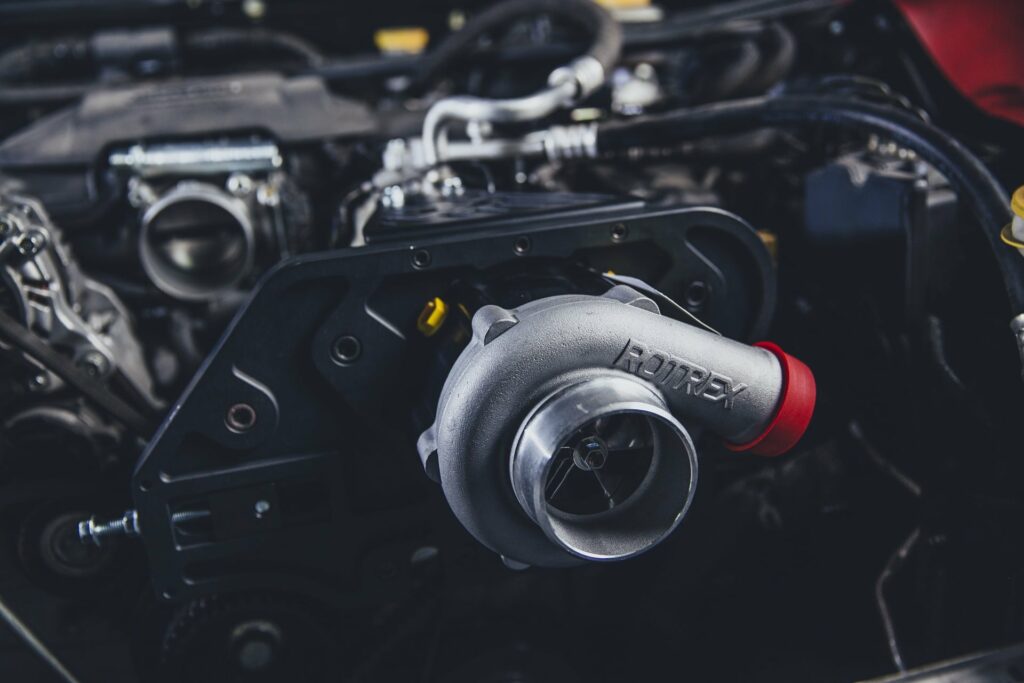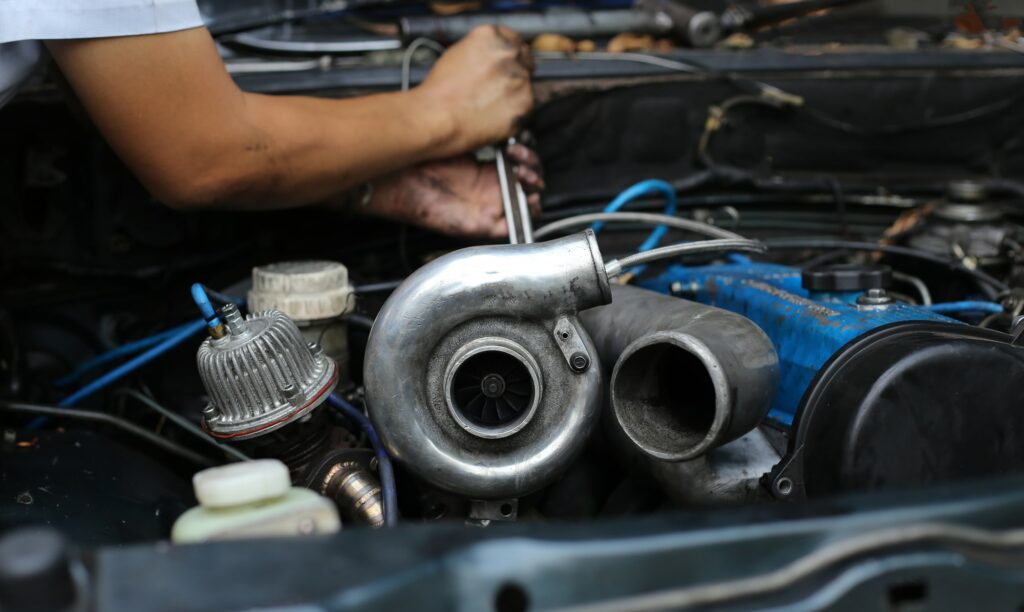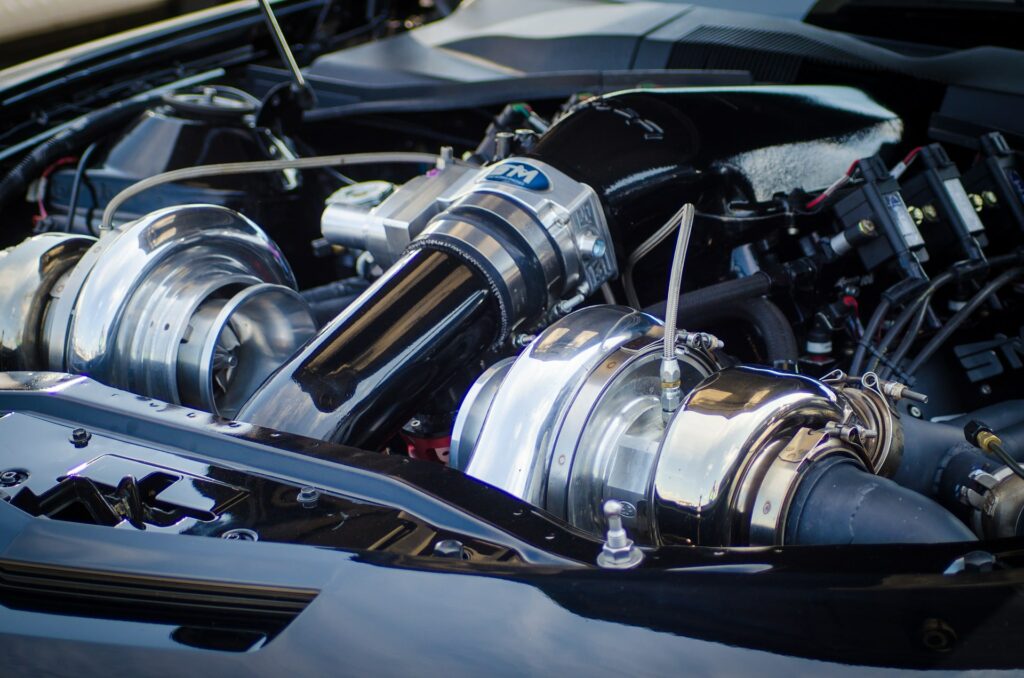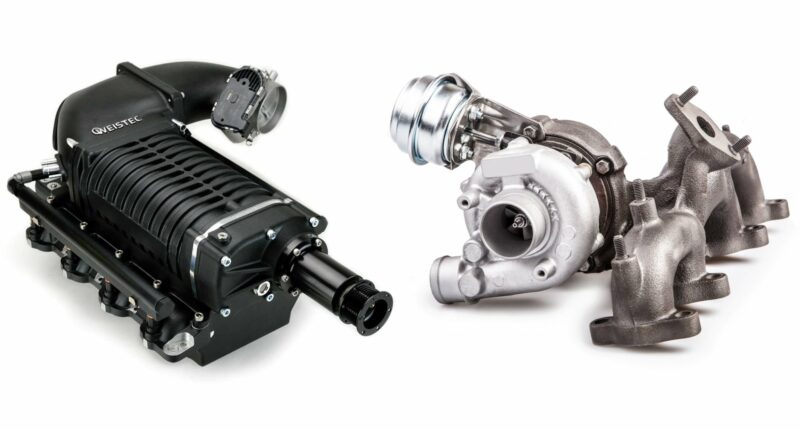If you’re looking to produce tons of horsepower to push your car to the next level, it’s hard to beat what turbos and superchargers can give you.
But how do these horsepower boosting machines work, and what do you need to know about them before you bolt them on?
In this comprehensive guide, we’ll break down everything you need to know in the supercharger vs turbo debate and help you pick the right one for your driving needs.
Forced Induction Basics
A naturally aspirated engine gets all the oxygen it needs through an intake process that uses a vacuum to draw in air. While it’s an effective process for most engines, you’ll need a lot more air if you’re trying to amp up the power.
That’s because, in all engines, there are three major components needed to create power:
- Air
- Fuel
- Ignition
The hiccup for most engines in creating more power lies in drawing in more air, which is where forced induction comes in.
Forced induction works by taking extra air and forcing it into the engine. While there are several different ways to get the job done, using superchargers and turbos are some of the most effective ways in increasing your engine’s horsepower.
What Is a Supercharger?
You can’t break down the differences between a turbo and a supercharger if you don’t know how they both work.

A supercharger is nothing more than an air compressor on a vehicle that forces that air into the engine. There are tons of different ways to do it, and in fact, a turbocharger is a type of supercharger.
Types of Superchargers
There are three different types of superchargers — roots, twin-screw, and centrifugal. The difference between all three is in how they move the air.
Roots Superchargers
One of the oldest superchargers out there, the roots superchargers work by utilizing two gears that spin and as they do, their lobes mesh together creating pockets of air and which is then drawn into the engine.
Both its gears meet at the top but leave tons of space in the middle for the air. When it opens back up on the other side, it pushes the air out, and the process continues.
Twin-screw Superchargers
While these superchargers use the same design as the roots-type, the difference here is that the lobes are shaped differently and they resemble worm gears. As the lobes twist together, it allows them to compress the air as they rotate.
Centrifugal Superchargers
These superchargers are technically impellers. They create high-speed air with little pressure, which is why these superchargers get paired with a diffuser. They slow down the air and pressurize it, which the engine then uses to generate more power.
While there are three different types of superchargers, twin-screw superchargers and centrifugal superchargers are what you’ll find in most vehicles today. They’re both far more efficient than roots superchargers, even if they are more expensive.
What Is a Turbocharger?
While turbochargers are technically superchargers, no one in the automotive world refers to them that way. That’s because while the result is the same, the way they achieve their results is entirely different.
Traditional superchargers are engine driven, whereas turbochargers are turbine driven. The vehicle’s exhaust powers turbochargers while the crankshaft powers superchargers. Therein lies the difference.
Types of Turbochargers
Unlike superchargers, which have three distinct styles, there are quite a few types of turbochargers.

We’ll highlight the six most common ones here.
Single Turbo
These turbochargers work by directing exhaust air back through the turbine, which then forces it into the engine. They vary in size — the larger they are, the more powerful. However, larger turbos don’t work as well at lower RPMs, while smaller turbos can’t create as much boost.
Twin-Turbo
Just as the name implies, there are two turbos — both of which are single-turbos. Even in the twin-turbo design, there are two different setups.
Some setups dedicate separate turbos to different RPM ranges, while others dedicate one turbo to each cylinder bank (in V6 and V8 configurations).
Twin-Scroll
Essentially these turbochargers work with vehicles with dual exhaust systems. They work with a complex system that directs exhaust from specific cylinders back to those cylinders for maximum performance.
Variable Geometry Turbocharger (VGT)
VGT turbochargers come with a ring of aerodynamic vanes that help the turbo’s air output match the engine’s current performance.
Variable Twin-Scroll Turbocharger (VTS)
These turbochargers combine the two technologies in VGT and twin-scroll turbochargers for even better performance.
Electric Turbocharger
While the name might imply a fully electric turbocharger, electric turbochargers are electric-assisted. The electric side of the turbocharger only works at lower RPMs, which is where traditional turbochargers struggle the most.
The advantage of this is that it entirely eliminates turbo lag, and it allows larger turbos to produce boosts at lower RPMs.
While electric turbos have tons of advantages, they are typically far more complex and expensive. Moreover, they create a lot of heat, which can damage the electric motor on the turbo if it’s not adequately cooled.
Superchargers & Turbos: How They Work
While superchargers and turbochargers are both forced induction systems that deliver high horsepower gains, the way they function is very different.
It is precisely these major differences that will ultimately influence your decision when choosing between the two.
Source of Energy
If you’re wondering what really sets turbo and a supercharger apart, it all comes down to how they’re powered. Superchargers are belt or chain-driven and derive their power directly from the crankshaft.
Meanwhile, turbochargers utilize exhaust air and force it back into the engine. After reading this, you might be wondering why you can’t use both, and the truth is you can, it’s called twincharging. You just have to make sure your engine block can handle it first…
Power Delivery
While both turbochargers and superchargers deliver significant power boosts, they do it in the same way — by forcing more air into the engine.
The most significant difference in power delivery is that while turbochargers have to spool up to get enough exhaust to feed back into the engine, a supercharger generates that power as soon as the engine starts to speed up.
This means where turbochargers have what is known as turbo lag, superchargers produce near-instantaneous power.
Installation
Installing either a turbocharger or a supercharger can be a complicated process, especially if your vehicle is a naturally aspirated engine. Upgrading an existing turbo or supercharger is much easier.
These components can be so tricky to install because there’s no place to put them on a naturally aspirated engine. For you, this means making a ton of modifications just to see the results, and what you need to do varies from vehicle to vehicle.

Whether you’re upgrading your current kit or adding forced induction to your car for the first time, it’s critical that you get a tune-up before you start the engine back up. Otherwise, you will end up breaking things.
Turbochargers and superchargers create phenomenal results, but your engine isn’t ready to handle them unless you let it know what’s coming!
Turbo vs Supercharger: Pros & Cons
While both turbos and superchargers can boost your engine’s power, they both have their own perks and disadvantages. So what’s better, a supercharger or a turbo?
The answer really depends on your setup. Because in the end, the supercharger vs turbocharger debate all comes down to what works best for you.
Turbocharger
Turbochargers are wonderful components that you can slap on your engine to boost your overall power output without a lot of the extra work that superchargers require.
They aren’t perfect, but they’re still horsepower generating monsters that can give your vehicle a competitive edge on the track, and even make your car louder due to turbo flutter.
Pros
There are two main reasons that people stick with turbochargers. First, they are far easier to install and far more affordable to purchase. In short, they’re hella convenient.
Secondly, they still produce a ton of extra power. Whether you’re upgrading to a bigger turbo or transforming your naturally aspirated engine, get ready to see some significant results.
Turbochargers are the undisputed easiest way to see significant improvements to your engine’s power output.

Also, they’re far more efficient than superchargers. While it might sound counterintuitive that the more efficient choice produces less power, it’s just because it has less to work with.
If you can keep speeding up the engine, you can keep getting more power, which in turn gives you more air, which in turn gives you more power. Turbochargers limit your power output to what’s coming out of the exhaust.
Cons
Turbochargers come with tons of advantages over their supercharger counterparts, but that doesn’t mean that they’re always the better choice. In fact, if all you care about is power, a supercharger might be the better option.
There are two reasons for this. The first is turbo lag.
It takes time for your engine to recirculate the exhaust gas back up to the engine when you step on the gas. The time it takes to spool up is a lag, and this has a noticeable impact.
The second is overall power output. While turbochargers do a great job at increasing overall power output, they don’t compare to superchargers.
Supercharger
When it comes to ultimate power delivery and monster boosts, it’s tough to beat what superchargers have in store for you.
But it’s not all rainbows and butterflies in supercharger land. Here’s a list of all the pros and cons you can expect from a supercharged setup.
Pros
The most significant advantage here is that the power is instantaneous. There’s no such thing as supercharger lag here. As you rev the engine, the supercharger instantly starts to spin faster, which gives you more power.

From there, superchargers actually deliver more power than turbochargers. They do this despite the fact that they are actually less efficient. Since the crankshaft drives the supercharger, the faster it spins, the more it taxes the engine.
But the most important factor people looking to decide between a supercharger and a turbocharger want to know is how much more power they’ll add. So, how much horsepower does a supercharger add?
If your vehicle didn’t have a supercharger before, you’re looking at close to a 45% increase in engine performance. So, if you have a 300 horsepower vehicle, you’re looking at adding close to 135 horsepower by installing a supercharger.
Of course, this depends on your car, the quality of the supercharger you add as well as other supporting car parts, so you might get results that are either better or worse.
Cons
The biggest drawback to a supercharger is that they are pretty big fuel hogs. While most people shooting for top-end performance aren’t overly worried about their fuel efficiency, if you’re slapping a supercharger on your daily driver it’s something you need to take into consideration.
From there, while there are tons of cars with turbochargers out there, most vehicles with superchargers are higher end. That means it’s far more likely you’ll need to do some fabrication work to get your supercharger working.
Turbo vs Supercharged Setups
When it comes down to choosing between what’s better — a supercharger or a turbo, the answer’s a little more complicated than a simple this or that. It all depends on what you’re trying to do with your new and improved setup and what power goals you have.
Below we’ll break down some of the most common considerations for a turbo vs supercharged setup.
Maximum Power
If you’re looking for the most powerful setup, there’s one right answer — both! There’s no rule saying that you only have to pick one or the other.
Just make sure that your entire setup can handle all that extra power if you plan on supercharging and turbocharging your engine.
If you are stuck with an either-or situation, superchargers are the more powerful of the two choices, but not by a wide margin.
Street Legal
It’s no comparison — while pretty much every turbocharged setup is street legal, you can’t say the same thing for supercharged engines. Whether it’s emission standards or fuel-efficiency regulations, superchargers often burn through them all.
While that doesn’t mean that you can’t find a street-legal supercharger setup — because you definitely can, if you’re not interested in the extra research, turbochargers are the way to go.

Though modern superchargers are much smaller than their predecessors, sometimes there is just not enough space under the hood. The old solution was simple — cut a hole in the hood! But this is rarely legal and can attract unwanted attention depending on where you live.
Better Fuel Economy
Superchargers wreck your fuel economy and are incredibly inefficient. The faster you go, the more fuel they’ll burn through.
Don’t get us wrong, it’s not that a turbocharged engine will improve your fuel economy — because it won’t, but it’s just not nearly as bad as a supercharged engine.
A quick point of clarification here on turbocharged engines. Manufacturers are using turbochargers to improve fuel economy on their vehicles — but this is only because they’re taking out larger engines and substituting them for smaller ones with turbochargers to reach the same performance levels!
If you’re installing a turbocharger upgrade, you’re not simultaneously installing a smaller engine. That would defeat the purpose of the performance upgrade!
Easier to Install
This really depends on your current vehicle, but the answer is almost always a turbocharger.
Not only do far more vehicles come with turbocharges so all you need to do is replace the smaller turbocharger and tune the engine, but they also don’t typically require as many modifications.
If you’re installing a turbocharger or a supercharger on a naturally aspirated engine, you’ll need to make modifications, but there are usually more turbo kits out there than supercharger kits.
Neither option is wrong, and you might find that a supercharger is easier to install on your vehicle, but this usually isn’t the case.
Cheaper to Install
Neither turbochargers nor superchargers are cheap, especially when you factor in the necessary tune. But when it comes down to installation, turbochargers usually have the edge when it comes to price.
Not only are the chargers themselves typically a little cheaper, but the easier install usually racks up some savings too.
While you might be looking to save a few bucks, make sure you do your homework on your setup before your start swapping any parts, though.
At a minimum, you’ll need a tune, but many vehicles need blow-off valves, intercoolers and other upgrades to fully handle all the extra horsepower you’re strapping to them.
Don’t skimp on these upgrades, or else you’ll end up paying far more for repairs a little while down the road.
The Final Say
If you’re looking for a way to increase your horsepower drastically, you won’t find a better way to do it than with a supercharger or a turbo. While there’s a lot of debate about which one is better, there really is no right or wrong answer.
Heck, technically, a turbocharger is a supercharger since a supercharger is anything that “increases the pressure of the fuel-air mixture in an internal combustion engine,” according to Oxford.
Instead of getting wrapped up in the debate, find the best setup for your vehicle and hit the road with more power than ever!
Do you still have questions about turbochargers and superchargers? Drop a comment below. Otherwise, check out our guide to the best tuner cars to add some forced induction to!

